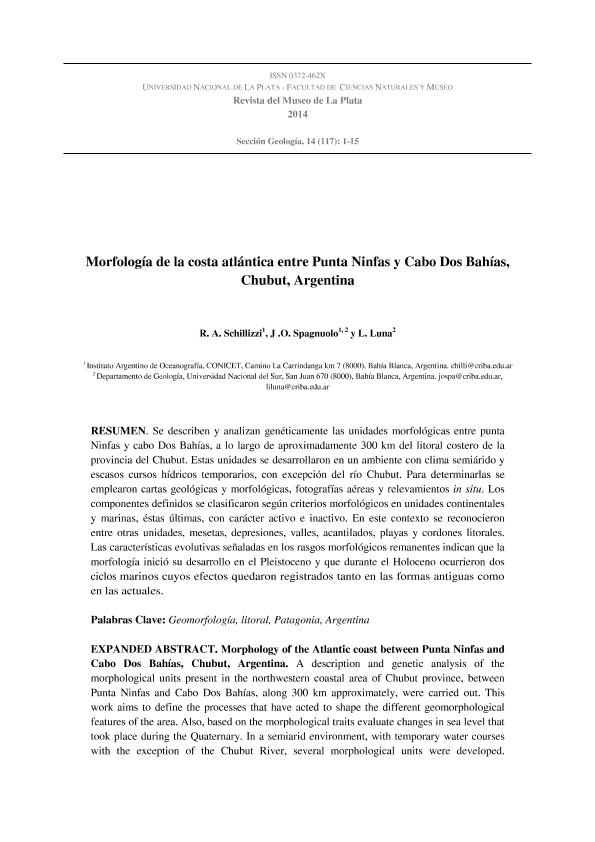Mostrar el registro sencillo del ítem
dc.contributor.author
Schillizzi, Roberto Antonio

dc.contributor.author
Spagnuolo, Jorge Osvaldo

dc.contributor.author
Luna, L.
dc.date.available
2017-02-06T21:04:58Z
dc.date.issued
2015-04
dc.identifier.citation
Schillizzi, Roberto Antonio; Spagnuolo, Jorge Osvaldo; Luna, L.; Morfología de la costa atlántica entre Punta Ninfas y Cabo Dos Bahías; Universidad Nacional de la Plata. Facultad de Ciencias Naturales y Museo; Revista del Museo de La Plata. Sección Geología; 14; 117; 4-2015; 1-15
dc.identifier.issn
0372-462X
dc.identifier.uri
http://hdl.handle.net/11336/12569
dc.description.abstract
Se describen y analizan genéticamente las unidades morfológicas entre punta Ninfas y cabo Dos Bahías, a lo largo de aproximadamente 300 km del litoral costero de la provincia del Chubut. Estas unidades se desarrollaron en un ambiente con clima semiárido y escasos cursos hídricos temporarios, con excepción del río Chubut. Para determinarlas se emplearon cartas geológicas y morfológicas, fotografías aéreas y relevamientos in situ. Los componentes definidos se clasificaron según criterios morfológicos en unidades continentales y marinas, éstas últimas, con carácter activo e inactivo. En este contexto se reconocieron entre otras unidades, mesetas, depresiones, valles, acantilados, playas y cordones litorales. Las características evolutivas señaladas en los rasgos morfológicos remanentes indican que la morfología inició su desarrollo en el Pleistoceno y que durante el Holoceno ocurrieron dos ciclos marinos cuyos efectos quedaron registrados tanto en las formas antiguas como en las actuales.
dc.description.abstract
A description and genetic analysis of the morphological units present in the northwestern coastal area of Chubut province, between Punta Ninfas and Cabo Dos Bahías, along 300 km approximately, were carried out. This work aims to define the processes that have acted to shape the different geomorphological features of the area. Also, based on the morphological traits evaluate changes in sea level that took place during the Quaternary. In a semiarid environment, with temporary water courses with the exception of the Chubut River, several morphological units were developed. Morphological and geological maps, aerial photographs (1:20.000 scale) and in situ detailed surveys data were used to determine the units present in the area. Topographical profiles between tide levels using the Emery method adapted to large beaches were performed and morphological examinations into the continent were made up to about 10 km from the coast. Tectonically, are classified as Trailing edge coasts. According to its structure are rugged coastlines. Correspond to coasts under the action of storm waves caused by winds reach 10 m/s. Among the morphological units continental and marine types were recognized. The continental forms are integrated by terraces, depressions, valleys and gullys. Among the marine units active and inactive units were found. The active marine units determined were: cliffs, beach ridges, beaches, wave-cut platforms, coastal dunes and tombolos. The inactive marine units determined were: palaeo cliffs, coastal lagoons and raised beaches. In the morphological modeling area have involved reactivation tectonic processes in conjunction with changes in sea level. The structures of positive and negative relief would be linked to tectonic reactivation occurred during the Pleistocene. The Holocene initiate with a transgressive cycle; towards the middle Holocene around 6000 yr BP began a regressive cycle leaving raised beaches, boulder beds and coastal lagoons in sedimentary silting process. One last ingressive cycle between 4000 and 2000 BP have modeled some bays, beach ridges, wave-cut platforms and notches originated at the foot of the cliffs. The presence of a step in the abrasion wave-cut platforms may be an index of sea level fall and a current period of stabilization. At present, marine erosion is favored in jointed wave-cut platforms. Sedimentary material generated by marine erosion (sand and pebbles) are transported by the action of longshore drift. To the northern sector of the study area the beaches are open type while southward pocked beaches are dominant. Cliff top dunes occur in bays closed by cliffs.
dc.format
application/pdf
dc.language.iso
spa
dc.publisher
Universidad Nacional de la Plata. Facultad de Ciencias Naturales y Museo

dc.rights
info:eu-repo/semantics/openAccess
dc.rights.uri
https://creativecommons.org/licenses/by-nc-sa/2.5/ar/
dc.subject
Geomorfología
dc.subject
Litoral
dc.subject
Patagonia
dc.subject
Argentina
dc.subject.classification
Geología

dc.subject.classification
Ciencias de la Tierra y relacionadas con el Medio Ambiente

dc.subject.classification
CIENCIAS NATURALES Y EXACTAS

dc.title
Morfología de la costa atlántica entre Punta Ninfas y Cabo Dos Bahías
dc.type
info:eu-repo/semantics/article
dc.type
info:ar-repo/semantics/artículo
dc.type
info:eu-repo/semantics/publishedVersion
dc.date.updated
2017-02-03T17:52:03Z
dc.journal.volume
14
dc.journal.number
117
dc.journal.pagination
1-15
dc.journal.pais
Argentina

dc.journal.ciudad
La Plata
dc.description.fil
Fil: Schillizzi, Roberto Antonio. Consejo Nacional de Investigaciones Científicas y Técnicas. Centro Científico Tecnológico Bahía Blanca. Instituto Argentino de Oceanografía (i); Argentina
dc.description.fil
Fil: Spagnuolo, Jorge Osvaldo. Consejo Nacional de Investigaciones Científicas y Técnicas. Centro Científico Tecnológico Bahía Blanca. Instituto Argentino de Oceanografía (i); Argentina. Universidad Nacional del Sur. Departamento de Geología; Argentina
dc.description.fil
Fil: Luna, L.. Universidad Nacional del Sur. Departamento de Geología; Argentina
dc.journal.title
Revista del Museo de La Plata. Sección Geología
dc.relation.alternativeid
info:eu-repo/semantics/altIdentifier/url/http://www.fcnym.unlp.edu.ar/uploads/docs/rmlp_geo_2014_t14_n117_schillizzi_etal.pdf
Archivos asociados
